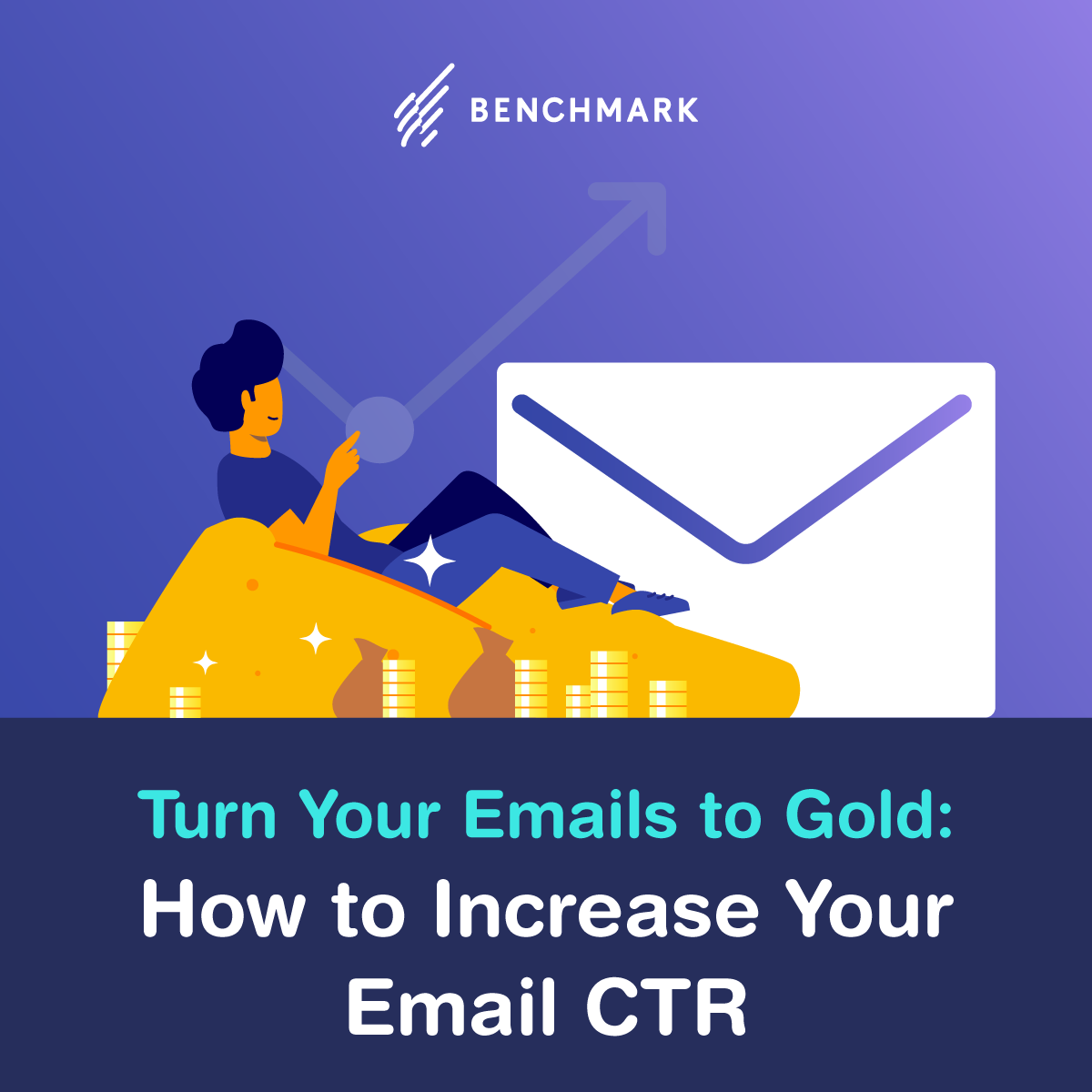EMAIL MARKETING
Turn Your Emails to Gold: How to Increase Your Email CTR

There’s gold at the end of the rainbow when it comes to your email marketing — you just need to make sure you’re on the right track towards finding it.
Email has one of the most impressive ROIs of all marketing endeavors at $38 earned for every $1 spent. That alone should be a huge incentive to get it right. However, there are many less tangible benefits that are equally worth your pursuit — including increased brand awareness and recognition, higher conversion rates, and a more satisfied, more engaged audience.
Of course, these benefits don’t happen overnight, nor are they a guarantee. To make email marketing work for you and reach that elusive pot of gold, you need to strategize. Set your sights on specific tactics and outcomes that can take your emails to the next level and help you get more bang for your buck when combined with other best practices.
In this guide, we’re focusing on one of the metrics that play a huge role in the overall success of your email marketing: your click-through rate. We’ll be covering why it’s so important, along with simple things you can do to create your own luck and get more clicks that matter.

What is an Email Click-Through Rate?
Your click-through rate (CTR) refers to the ratio of people who click on a link in your email versus the number of people who saw it.
For example, let’s say you send out 10,000 emails and get 2,000 leads to a click on one of your email’s links. Your click-through rate would be 20 percent, using the CTR formula of the number of clicks divided by the number of opens multiplied by 100.
Notable here is that the dividing factor is the number of impressions, not the number of opens, with every delivered email counting as an impression. If you send out 10,000 emails and only 9,500 make it to an inbox (meaning they don’t bounce or get sent to spam), then you would divide by 9,500, not 10,000.
How Does CTR Compare to Other Email Metrics?
Click-through rate should be studied in conjunction with other email metrics to get a complete picture of the efficiency of your campaign. Click-through rate and open rate are considered to be the top email metrics, but neither should be fully relied on for email success.
Open rate looks at the number of recipients who open your emails. This metric is useful but not as compelling if those same recipients don’t convert or click on your links. Also, with Apple’s iOS15 update, open rate is ultimately inaccurate, depending on how many of your subscribers are Apple users and have opted into the new privacy features.
Click-to-open rate combines the insight from open rate and CTR to provide a more concrete measurement of success. It combines open rate and click-through rate by taking the percentage of recipients who open your emails and click your links.
Why Your Email CTR Matters
Your click-through rate clues you in on a few key insights that you can’t gain from looking at your deliverability and open rates alone. These include:
- How engaged your audience is
- How interested your audience is in the content you’re sharing
- How audience interest changes over time
If you’re looking at your CTRs and aren’t impressed by the numbers, you’re not alone. The average click-through rate is quite low, with an industry-wide CTR of just 2.6%. The industry with the highest click-through rates — government and politics — clocked in at just 6 percent. Retail came in at the lowest, with a CTR of 1.10 percent. Yikes.
What makes this metric so elusive is exactly what makes it so essential to your overall email marketing success. Getting into an inbox and getting an open are big steps, but it’s your click-through rates that really bridge the gap between subscriber and lead or customer. CTRs tell you who’s interested in what you’re selling, and even more notably, who’s most likely to buy.
What’s a Good CTR?
Click-through rates vary by industry, and if you search the web, you’ll find a ton of different answers regarding what the average email CTR rate is and what a good CTR rate is. From our experience and research, we’d say that an average click-through rate is around 2.5 – 2.6%, making anything above that pretty darn good.
The Various CTRs
Yes, there are “categories” of CTRs to keep in mind. Knowing more about what they are will help you determine what you’re measuring.
- TCTR or total click-through rate – Measures the total number of clicks the links in your email receives. If your TCTR is high, that means the recipients of your email opened and clicked on the link in your email multiple times. We don’t recommend relying on this for success, as you can’t differentiate between which clicks are from the same person on multiple devices (or if links are just being clicked on repeatedly).
- UCTR or unique click-through rate – Measures how many unique clicks each link gets in an email. If a recipient opens the same email on two different devices, it will only be counted once, which helps avoid the confusion that comes with TCTR. In a nutshell, unique click-through rate tracks how many links are clicked by each unique subscriber.
5 Ways to Increase Your Email Click-Through Rate
Now let’s get to the good stuff: the specific things that you can do to boost your click-through rate and, by default, your email performance.
You might be doing some of these already since there’s a significant overlap between the tactics that improve your CTR and the tactics at the foundation of basic email hygiene. But the more, the merrier, so look through to see if there are any gaps in your email marketing strategy that could inadvertently be harming your CTR.
1. Make Your Emails Mobile Friendly
There’s a strong connection between the device that your subscribers are using and how often they click through, especially when you consider that 70% of your subscribers will automatically delete an email that isn’t optimized for their device.
In the U.S., mobile internet traffic is gaining speed on desktop, accounting for 40.61% of all traffic in the first quarter of 2019. If your emails look great on a computer but don’t translate into a mobile format, you’re taking a huge risk — and likely losing out on a ton of potential clicks in the process.
A responsive email design on mobile can increase your click-through rate by 15%, from a 2.7% average CTR to a 3.3%. Not too shabby for such a simple fix.
2. Rethink Your Layout
A simple email redesign can have a serious impact, and that includes increasing your CTR.
Making conscious email design choices that point your audience in the direction of your most valuable links isn’t sneaky — it’s smart thinking. Put the focus on your content and your CTA, and take it off heavy blocks of text and non-essential images.
If you aren’t sure about a certain layout, test two different kinds to see which yields higher results.
3. Test, Test, and Test Again
A/B testing is your friend when it comes to email conversion rates, particularly your CTR. So why are so few brands doing it?
More than 65% of brands rarely or never A/B test their automated emails. But set-it-and-forget-it complacency isn’t where great emails come from. You want to regularly test out features that impact your key conversions to see what tracks best with your audience and what’s failing to grab their attention.
Go into your A/B testing endeavor with a clear idea of what you’re trying to find out. In terms of your click-through rates, that’s going to be things like link placement and size, the time and day you send your emails, and how you position your copy around the link to encourage clicks.
Will a blue button garner more clicks than a yellow one? Will including an image with your CTA increase your rates? Will you get a higher CTR if you send on Thursdays instead of Wednesdays? A/B testing can answer these questions — and take the guesswork out of what features need to be a mainstay of your campaigns.
4. Include Just One CTA
More than 90% of subscribers who read your headline copy also read your CTA copy. And while it’s tempting to want to cast a wide net with your CTAs, it pays to keep eyes on the prize.
Content clicks are crucial, but your CTA is where the gold is. By narrowing it down to just one — and making it stand out as much as possible — you help ensure that the click-throughs you do get are of the highest value. It plays off of one of the biggest marketing design truisms, which is that when it comes to choice, less actually is more.
Once again, A/B testing is important. In addition to playing around with colors, fonts, and formats, thoroughly test your CTA placement so that you really make it count.
5. Target Your Content
Segmenting your audience so that you send the right content to the right people can boost your conversion rates by more than 203%.
Your audience is busy, and they’re usually rushing through their emails. To snag their attention, everything from your subject line to your body copy needs to be optimized to their preferences, interests, and where they are in the sales funnel. The more personal you can get, the more likely you are to capture their interest — and turn that interest into a click.
If it sounds like a lot of back-end work to ensure you send out targeted content, you’re in luck. Email marketing automation can do a ton of the heavy lifting of personalization and contact list segmentation for you. All you have to do is make sure you’ve accurately defined your audience groups in the first place. In fact, email marketing automation can help you with A/B testing and quicker reformatting — all of which are integral to acing your CTR game.
Any click-through rate boost you can get is worth striving for. Follow the advice above to start gaining more clicks, more leads, and more happy customers.
First seen at Benchmarkemail.com



















You must be logged in to post a comment Login